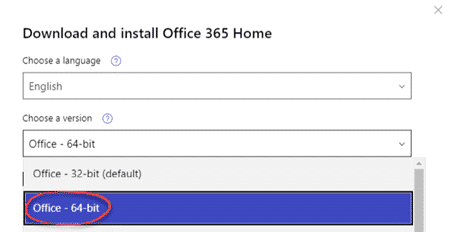Now that Microsoft is changing the default Office 365 and Office 2019 install to 64-bit software from 32-bit software – which one do you choose and does it matter?
Most people will not notice the difference between 32-bit Office and the 64-bit version. The latter is faster but not so much better that you’d realize without special benchmarking tests.
Let’s start with what’s important for 95% plus of the people reading this …
Should you care about 32/64 bit?
Stay with the Microsoft Office for Windows you have either 32-bit or 64-bit, unless you have a specific reason to change.
As simple as that, stick with the ‘devil you know’.
Maybe moving to 64-bit Office will be faster, but any small combined time savings could be less than the time taken uninstalling and reinstalling Office!
Move to 64-bit Office
Choose the 64-bit Office option if you’re installing Office 365/2019 on a new computer or doing a full reinstall on an existing computer.
Check first that’s there’s no add-in or VBA compatibility problems. They should be rare these days.
From your Microsoft account, choose Install Office then More options. Choose Office 64-bit.
You won’t be able to install 64-bit Office on 32-bit Windows so won’t worry about compatibility. The installer with stop with an error message very early in the process if that’s a problem (just go back and choose ‘Office 32-bit’ instead). Windows 8.1/10 32-bit versions do exist but it’s increasingly rare, see below for details.
Sometimes 32 vs 64 bit doesn’t matter
There’s no 32/64-bit option to worry about with Office for Mac, Office for Apple or Office for Android.
Confusion is understandable
Microsoft has changed their mind about 32/64bit several times over the years. At one stage it looked like they were moving everyone to 64-bit Office but they changed tack and stuck with 32-bit software.
Pushing 32-bit Office seems aimed at reducing support costs for Microsoft rather than what’s best for customers. At the time, there were more 64-bit incompatibility problems than should be around now.
The company also keeps these moves quiet. It seems they are overly worried about confusing customers about 32 vs 64-bit while overlooking the trouble caused by non-disclosure.
Which one do I have, 32-bit or 64-bit?
Microsoft hides the ‘bitness’ of Office at File | Account | About then look on the second line of the box with all the legalese.
What’s the difference?
64-bit Office makes better use of computer resources and especially computer memory.
32-bit Office can’t fully access memory over 4GB on many computers, it also needs a special translation layer in Windows to work with 64-bit Windows. That translation layer slows down Office a little.
The main advantage of 64-bit is with really large Excel worksheets which can make good use of the memory available and faster processing.
That large lumbering beast called ‘Microsoft Outlook’ can take advantage of the 64-bit benefits.
But in most cases, it’s hard to tell the difference between 32-bit and 64-bit Office. It’s nothing like the noticeable and sometimes jaw-dropping improvement when switching to SSD solid-state drives.
Can I use 64-bit Office?
Almost certainly yes. Most, if not all, new computers with Windows 8.1 or Windows 10 should be 64-bit.
There are Windows 10 and 8.1 32-bit releases. Mostly they were sent to anyone upgrading from a previous 32-bit Windows. Check at Control Panel | System for the bitness of your Windows.
64-bit software needs to run on a 64-bit operating system. Windows has defaulted to 64-bit software for many years/versions now. Any computer with more than 4GB of RAM has to use 64-bit Windows.
The downside of 64-bit Office
The concern with 64-bit Office is compatibility with add-ins.
Some add-ins or VBA code may still be limited to 32-bit Office. That should NOT happen now, developers have had many years to make their wares 64-bit compatible.
There was a problem with MPEG-4 video/audio for PowerPoint with Windows 64-bit see Office 64-Bit Won’t Work With MPEG-4 or Quicktime Video This seems to be fixed in Windows 64-bit.
See also: The Death of MP3, Rise of MP4 and Microsoft PowerPoint
Before switching to 64-bit check any add-ins or programs that link into Office. Make sure they are all 64-bit compatible.


